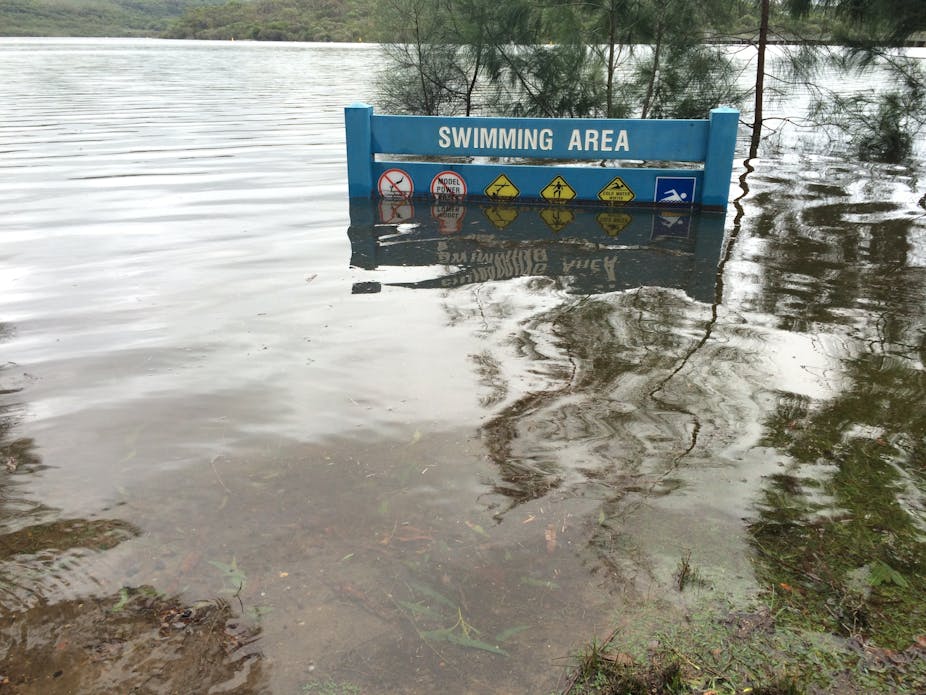The extreme rainfall that hit New South Wales over the past week caused flash-flooding and resulted in deaths and homes destroyed. While analysis shows that these events are not unprecedented, are they becoming more common?
In research published recently in Nature Climate Change, we show that extreme rainfall in Sydney is increasing, but mostly during the summer. Longer periods of extreme rainfall, such as the event we’ve just seen, haven’t changed or have actually decreased.
Warmer means wetter
One of the major concerns of climate change is that flood risk might increase. However, estimating the size of future change has proven to be challenging, in part because historical flood records are not only affected by changes in climate but also by changes to land use (such as urbanisation, dams, forestry, agriculture).
This means that it is difficult to use historical flood records as the basis for inferring future changes to flood risk.
An alternative approach relies on looking at historical changes to extreme rainfall patterns. The basic story of how extreme rainfall is expected to change under future climate change is linked to how much moisture the atmosphere can hold. For every degree of temperature increase, the atmosphere can hold 7% more water.
At the global scale, this has been found to be approximately true in both historical datasets and future model projections. However, changes at the local and regional scale are much more uncertain.
Types of rain
The type of rainfall is important. Convective events such as summer thunderstorms are driven by the instability of moist parcels of air due to temperature gradients, and can lead to localised, highly intense bursts of rainfall.
Stratiform rainfall (such as the kind that hit NSW over the past week) is linked to large-scale circulation patterns of the atmosphere such as fronts and east coast lows, and is often more widespread.
Understanding rainfall is not just a question of studying amounts and patterns, but appreciating the climate mechanisms that gave rise to the rainfall.
In our new paper, we show that summer rainfall – characterised by short, intense bursts – is becoming more intense. But intense rainfall in other seasons showed little change, or even decreased.
More research on the causes of these changes is certainly required, however our results are consistent with future climate projections of intensifying summer rainfall, and a reduced frequency of east coast lows.
What does this mean for flooding?
Whether rainfall causes a flood depends on where you live. In larger catchments, floods are mostly caused by long periods of extreme rainfall. In smaller, steeper and more urban catchments, floods are caused by short bursts.
This can lead to unexpected results for future flood risk. For example, a large catchment might have smaller floods because of less extreme winter events, yet a smaller upstream region of the same catchment may be subject to more intense flash flooding because of the increased intensity of summer extremes.
Assessing the magnitude of floods is a complex science with many interactions between rainfall and the catchment. The timing of rainfall, the size, steepness and shape of the catchment, the type of land use and the wetness of the catchment from prior rainfall events all act to modify the size of a flood.
Even if these factors were held constant, the fact that a single region such as the Greater Sydney basin can have multiple trends across timescales demonstrates the need for care in assessing the impact of future floods.
These issues are critically important for understanding future floods, and work is currently under way to better account for climate change as part of Australia’s national flood guidelines.
However, more work needs to be done if we are to understand the full picture of future flood risk across Australia’s diverse climates. Improving our ability to account for climate change will contribute to better design and security of our water infrastructure (dams, levees, bridges and storm-water drainage networks), the management of our floodplains, emergency response and community safety.
Read more:

